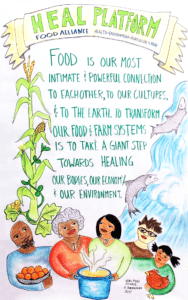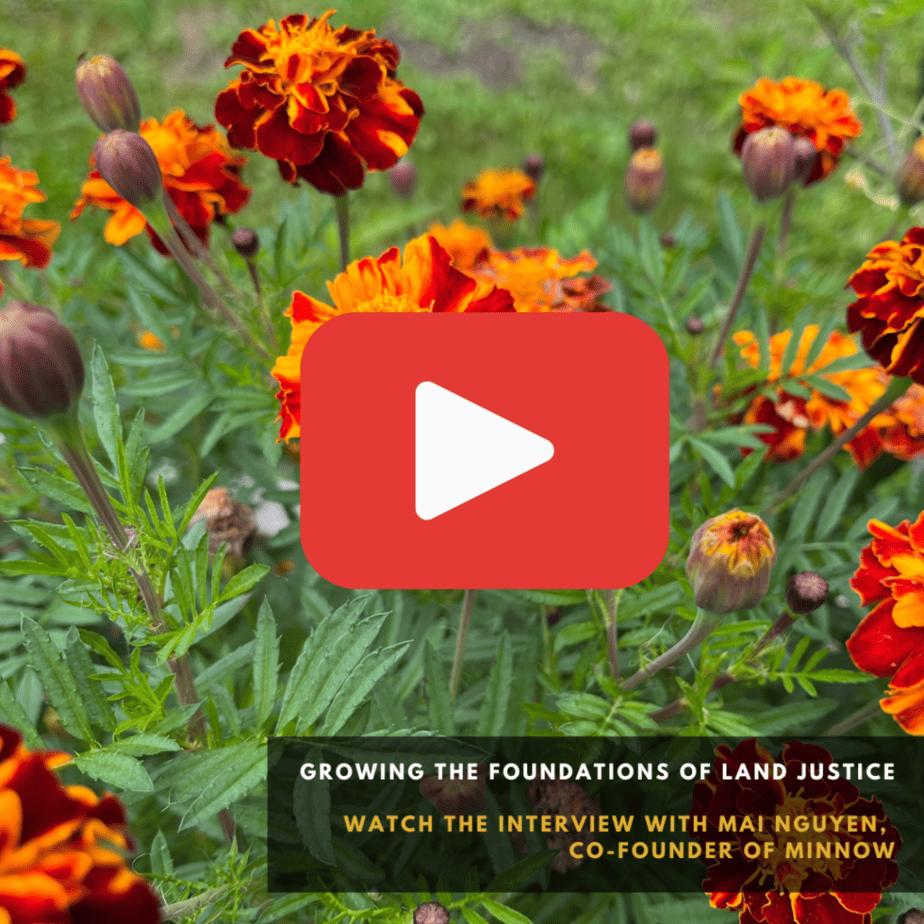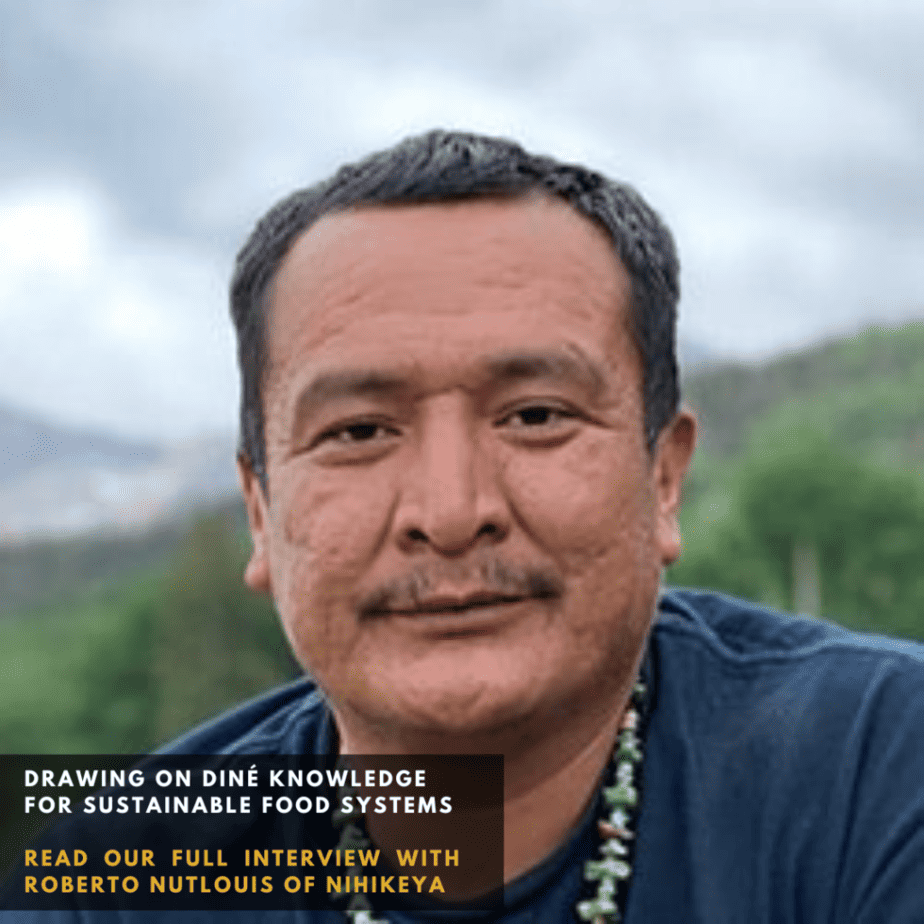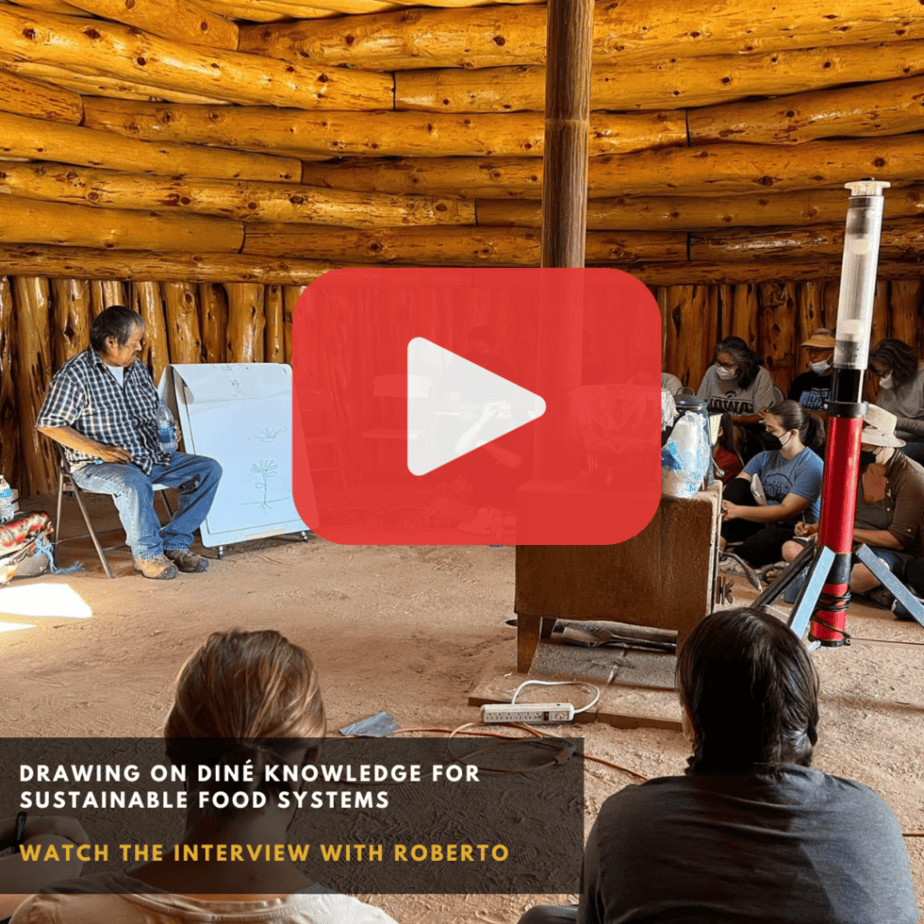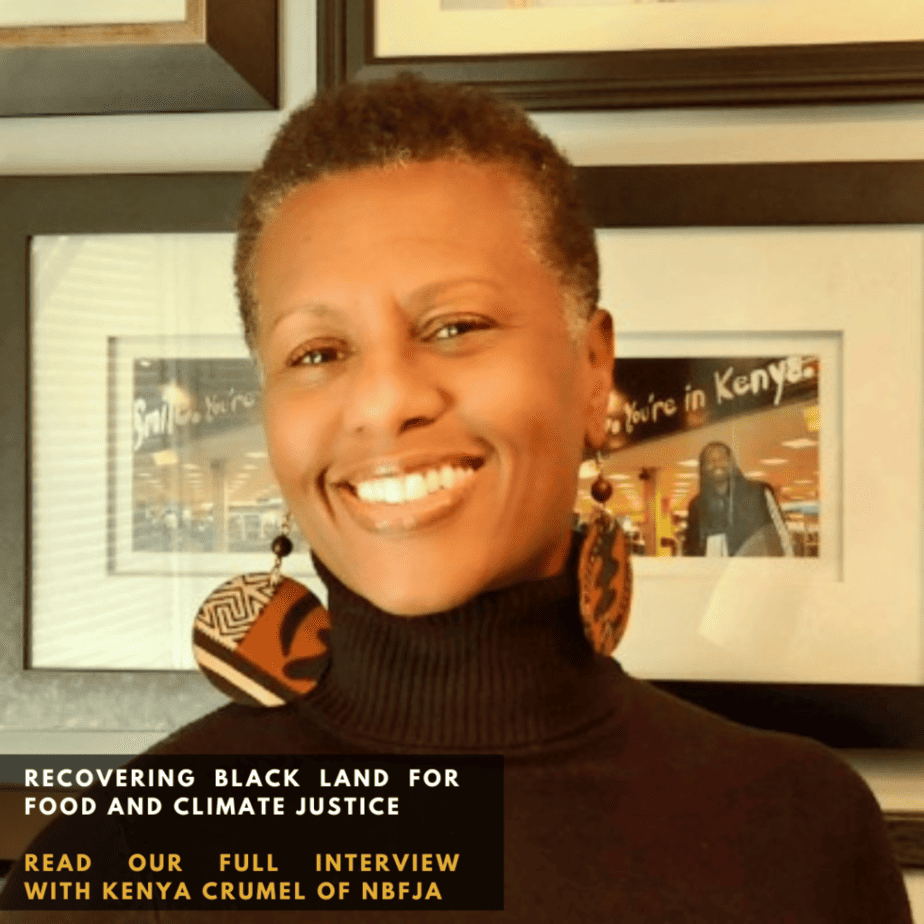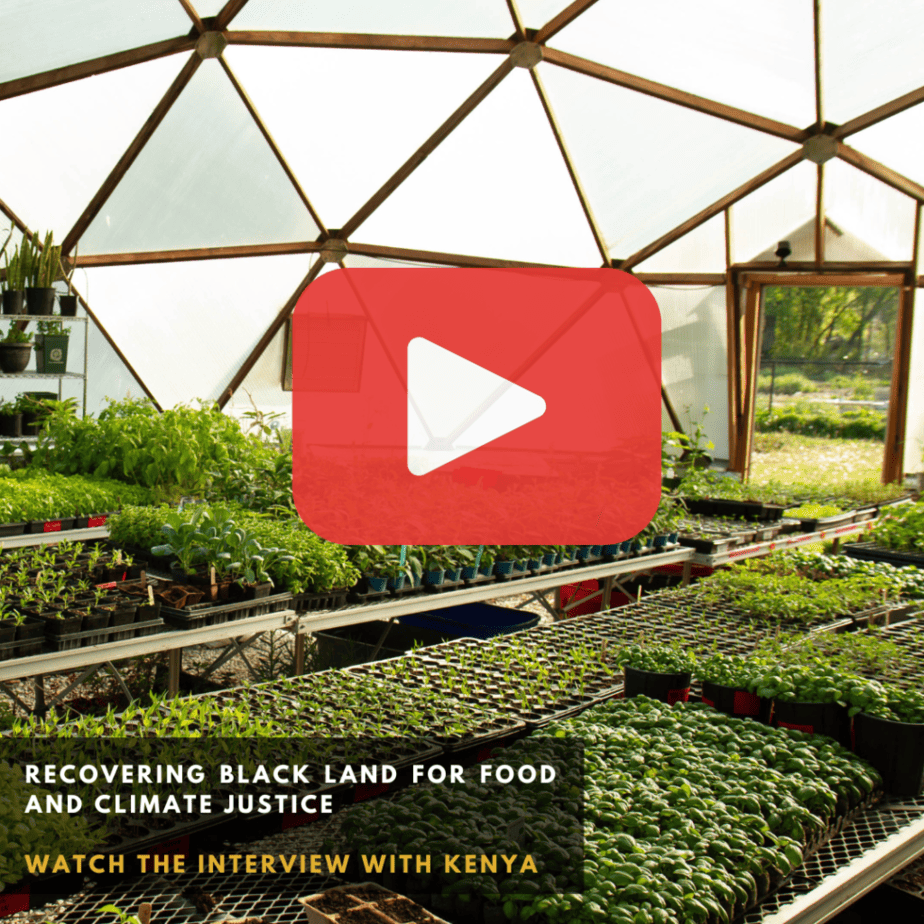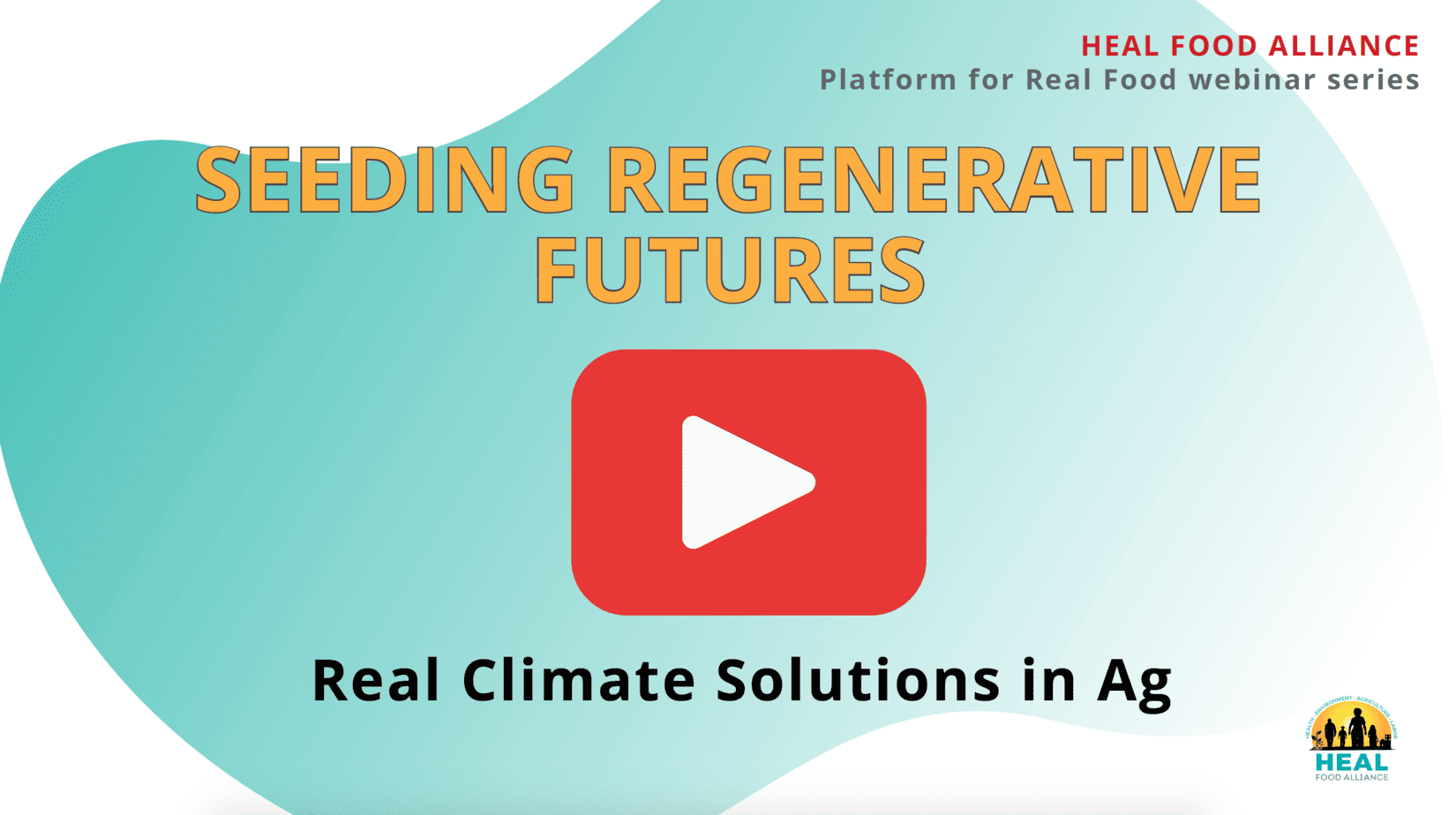To accomplish this, the policy infrastructure that supports food production, from research to technical assistance to insurance and credit, must primarily encourage the integration of the best of cutting edge agroecological science with the best of time-honored indigenous wisdom and agricultural and fishing traditions. Supporting this shift both domestically and internationally is necessary for the world to feed itself. Policymakers must recognize the impacts of other industrial activities, like deforestation, mining, and fracking, on fish populations and ecosystem management. The protection and development of sustainable farming, ranching, and fishing systems will support ecological and public health, with safer environments for farmers and workers, and more diverse, nutrient-rich diets for everyone.
HEAL Platform for Real Food
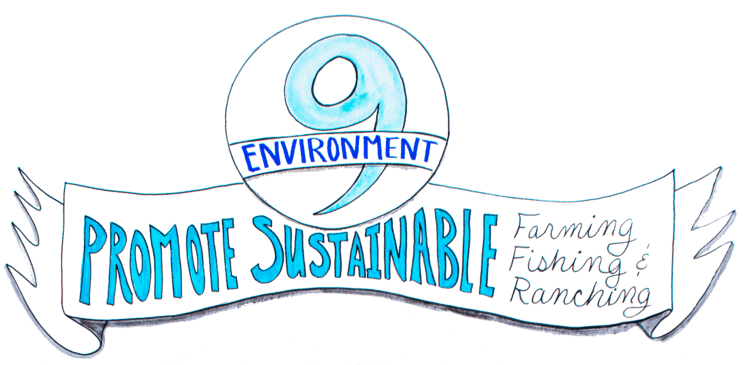
To accomplish this, the policy infrastructure that supports food production, from research to technical assistance to insurance and credit, must primarily encourage the integration of the best of cutting edge agroecological science with the best of time-honored indigenous wisdom and agricultural and fishing traditions. Supporting this shift both domestically and internationally is necessary for the world to feed itself. Policymakers must recognize the impacts of other industrial activities, like deforestation, mining, and fracking, on fish populations and ecosystem management. The protection and development of sustainable farming, ranching, and fishing systems will support ecological and public health, with safer environments for farmers and workers, and more diverse, nutrient-rich diets for everyone.
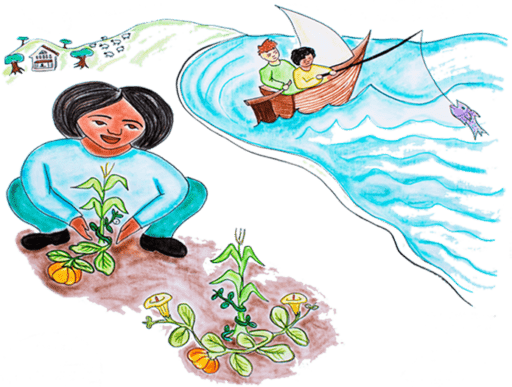
Our Solutions
- Restore classical and farmer participatory plant and animal breeding communities of practice with breeding objectives designed for sustainable systems
- Strengthen and then expand USDA conservation programs, with prioritization for BIPOC producers
- Establish new funding for the return of stolen land to Indigenous groups and tribes, reparations to those who lost land due to discriminatory lending practices, and the transfer of ownership of land to BIPOC producers
- Strengthen the regulation and prevention of agriculture-related environmental degradation from pesticides, toxic runoff, and carbon emissions
- Reform the federal crop insurance program to reward stewardship practices, and make real, measurable conservation a condition of eligibility for premium subsidies
- Expand technical and financial assistance for producers transitioning to diversified organic, regenerative, and agroecological production, including reduction of barriers to achieving and maintaining organic certification
- Revise USDA and NOAA research priorities to align with sustainability and climate change resiliency Increase overall funding for agroecological research and extension, especially through on-farm, producer-led research, and in land-grant universities
- Revise national fish management programs, such as the Catch Share program, that consolidate fishery ownership and produce negative ecological impacts
Background
Food is one of the most powerful connectors between people, cultures, and our environments. Through food, we sustain ourselves and our communities, as well as our relationships with other species, land, and water. For thousands of years, people around the world have used traditional and cultural practices to grow food in sustainable ways.
White supremacy, colonialism, and corporate greed have disrupted these relationships. Today, destructive agricultural practices in our farms and seas are replacing traditional food production methods to mass produce cash crops, producing a lot of waste in the process.
Future generations deserve to be able to grow and eat nutritious, plentiful, and culturally relevant food. They deserve to live and work in healthy, thriving environments. To get there, we must invest in regenerative, ecological agriculture, while removing extensive financial support for industrial forms of food production.
Extractive Food Systems
Across land and sea, corporations are replacing traditional ranching, farming, and fishing practices with industrial models. These models treat working people, land, water, wildlife, and surrounding communities as disposable. Globally, industrial agriculture produces around 40 percent of greenhouse gas emissions. It is also the single largest cause of biodiversity loss, contributing to the extinction of many plant and animal species (including many important insects). In the US, government policies enrich a handful of corporations and large-scale landowners, while pushing out smaller independent growers, including land stewards of color who have long maintained sustainable relationships with land and water. In spite of producing massive amounts of food, the US food system fails to deliver plentiful, affordable, and nutritious food to all of us.
Our survival, and that of many other species, depends on us shifting these practices. Instead of an extractive, industrial food system, we must move toward regenerative and reciprocal relationships with the land and each other. We must ensure that our food production practices benefit people and wildlife, restore land and ecosystems, store carbon, enhance biodiversity, and ensure that future generations can thrive.
Sustainable Agriculture
Sustainable traditions of cultivating and procuring food pre-date the founding of this country and today’s extractive food system. Sustainable, regenerative agriculture is rooted in the traditional ecological knowledge of people indigenous to this land, and by land stewards who have brought their traditions with them. Although there are many terms that people use to describe sustainable agriculture, true solutions all honor current and future generations of humans and ecosystems. And they steward land and water in non-extractive and reciprocal ways.
Land stewards of color and some small-scale food growers have long been leaders in using sustainable practices. People using these practices grow different crops together that nourish each other, the soil, and the ecosystem as a whole. They use cultural and biological methods (rather than toxic chemicals) to deter unwanted insects, weeds, and plant diseases. They treat farm animals with respect and care, and they preserve critical fish habitats. For thousands of years, herders have used integrated systems of animal husbandry and crop cultivation that work in harmony with ecological processes. Today, many small-scale ranchers continue these and other practices, like rotational grazing. Meanwhile, fishers using sustainable methods respect the ocean, fishing with the rhythms of the seasons and allowing fish populations to reproduce and flourish. Many of our member organizations are practicing and promoting these kinds of sustainable solutions – learn more about their work on our member stories page!
Explainers
Yes! The world already produces more than enough food for everyone to eat. And small farmers grow anywhere from 30 to 70 percent of the world’s food, using traditional and Indigenous practices. Studies show that farming in ways that care for the environment (like sustainable and agroecological methods) can grow a lot of food while also making our diets more varied and helping the environment. Small and sustainable farms actually produce more food per acre than industrial farms.
Even though we have plenty of food, as many as 738 million people worldwide don’t get enough to eat. In the US, over 30 million people aren’t sure if they’ll be able to consistently have food on the table. The problem is not about the quantity of food, it’s about how it’s distributed. Right now, not everyone can access the food that has been produced, because governments and politicians have passed policies allowing corporations to profit off of food systems. Food is a human right, and it should be available to all of us — not used to make a profit.
Meanwhile, industrial agriculture is simply unsustainable in the long term. Industrial farming requires huge amounts of water, fossil fuels, chemicals, and other resources that harm the soil and pollute our air and water. As it expands, more forests are cut down and important grassland and wetland ecosystems are destroyed. We are already seeing how this model of farming harms our communities, land, and the natural world around us.
Sustainable agriculture can produce enough food for everyone. But we must address distribution, rights, and political power to ensure that everyone has access to healthy, culturally relevant, and affordable food sources. This is why movements for agroecology go hand in hand with the movement for food sovereignty. (Food sovereignty means that people have the right to healthy food that fits their culture and is grown in ways that protect other beings. And it means that they can define their own food and agriculture systems.) We need big changes not only in how we farm, but also in what we eat, how we get food, and how we organize our societies and economies.
Not the way it’s currently being done, and not by itself.
For thousands of years, Indigenous communities and other stewards around the world have maintained good relationships with wild fish and the environments they live in. They honor the seasonal patterns and ecological needs of many species of fish and shellfish. They feed their communities but also consider the fish and make sure they can keep living.
Many Indigenous peoples have also practiced fish farming for many generations. In the Pacific Northwest, coastal Indigenous communities have been constructing and maintaining clam gardens for 3500 years. In Hawai’i, Native Hawaiians are restoring loko i’a (fish ponds) that have long played an important part in how they care for land.
Around the world, colonizers and a handful of large corporations have destroyed traditional fishing systems. This has harmed many fishing communities. Large industrial fishing operations have tried to catch as many fish as they can. In just a few generations, they have disrupted the ways that Indigenous peoples and other traditional fishing communities have been doing things for thousands of years. In the US, the government has dammed rivers and promoted destructive practices that benefit corporations and hurt fishing communities. These policies have been especially bad for Black fishers, Indigenous fishers, and other fishers of color. Now, some corporations, scientists, and government planners promote fish farming (aquaculture) as a solution to overfishing wild fish and shellfish.
Industrial fish farming is based on the same problematic structures that have caused declines of wild fish in the first place. Big fishing corporations produce a lot of fish through practices that harm workers, animals, society, and the environment. To raise certain kinds of fish (like salmon), they need lots of wild fish as food. Often, they take these wild fish from countries in Africa, Asia, and Latin America. This harms local fisheries in these places, making it difficult for people to get culturally and nutritionally important foods.
Industrial fish farming can create serious problems for marine life and can harm fishing communities. Industrial fish farms poison our water with untreated fish waste and spread harmful pests and disease. They sometimes have catastrophic accidents where farmed fish get released, which is dangerous for wild fish and other species that depend on them. And much like Concentrated Animal Feeding Operations (CAFOs) for livestock, operators use medications and chemicals to control disease and parasites caused by having too many fish in an enclosure. When these drug residues spread into waterways and local food chains, they can hurt other species and contribute to the problem of antibiotic resistance.
For aquaculture to meet sustainability goals, we must uplift practices that are low input and low impact. For example, we can expand farmed seafood production through appropriately-scaled mollusk or seaweed farms and systems like aquaponics (where plants and fish are grown together). We also need to make sure that there are rules that keep things fair and safe – and that these rules are enforced. And we should make sure that the people who live and work in fishing communities have a say in how things are done. Aquaculture policies must add to community control and self-determination, rather than helping corporations get bigger and richer.
But even if we farm fish in these ways, it can’t replace the important roles that wild fish play in environments and cultural practices. For example, there are Native nations and tribes whose cultures hold a special place for wild salmon. They base some of their traditional names for seasons on the timing of salmon returns. They structure their identities and lifeways around long-standing stewardship and mutual relationships with salmon. They center salmon fishing as a key ancestral and cultural practice. Simply producing more farmed salmon does not substitute for the deep ecological and cultural importance of wild salmon. To ensure cultural continuity and to respect the rights of wild species, we must ensure that sustainable fish farming is accompanied by policies and practices that restore wild fish stocks and reduce overfishing. We must:
- Set catch limits that consider complex food webs in the ocean.
- Develop and implement restrictions on catching young fish that haven’t had the chance to reproduce, and older larger fish that have higher reproduction rates than other fish.
- Establish seasonal restrictions based on when fish spawn.
- Establish Marine Protected Areas, which restrict people from fishing in specific places and allow fish to reproduce.
- Promote fishing methods that minimize bycatch (when other fish species are accidentally caught, in addition to the target species) and environmental harm, while discouraging or banning methods like industrial trawling that destroy delicate habitats and decimate fish populations.
- Remove dams that block fish from swimming where they need to go (and that are rooted in colonization).
- Restore river habitats.
On top of this, we also must continue fighting against the privatization of our oceans and protecting them as a public commons — read more in our toolkit!
Yes! For nearly 10,000 years, people have relied on both wild and domesticated livestock for food and cultural traditions. From the Sámi of northern Europe to the Diné of the Southwest US to the Fulani of West Africa, Indigenous peoples and other land stewards have built their cultures, diets, and ways of life around animals and their grazing patterns. Livestock are central to how many peoples relate to their homelands, their environments, and their own identities.
Many communities across the globe have long raised animals in humane and sustainable ways, benefiting farms and wider ecosystems. But colonialism and greed have disrupted these harmonious relationships. Around the world, colonial governments restricted the movement of people and their animals. In the US, the government and military actively encouraged white hunters to exterminate herds of buffalo, knowing their importance to Indigenous peoples in the Plains region. In the 1930s, the government killed off huge numbers of livestock held by the Diné, hurting food security and livelihoods. Over time, US policies have sought to undermine the ranching practices and knowledge of people of color. At the same time, politicians and corporations have promoted factory farming of livestock, leading to pollution, labor exploitation, and land degradation.
Scientists now support what ranchers of color have long known about animals’ beneficial roles in farm and ecosystem health. For instance, free range chickens can eat unwanted insects on farms. And livestock, when allowed to roam and graze in well-managed pastures, can improve soil quality, benefit waterways and fish habitats, and increase biodiversity. Farms with grazing livestock have very fertile soils that can store a lot of carbon, because they maintain continuous plant cover. Grazing-based livestock systems benefit the environment by reducing soil erosion, increasing animal health, and improving water quality and wildlife habitats.
To reap these benefits, we must move away from extractive and industrial factory farming. Instead, we need regenerative and humane models that respect and honor animals, working people, and the environment. Humane and sustainable livestock raising means:
- Allowing animals to engage in natural behaviors, like grazing.
- Not engaging in further deforestation and grassland clearance for livestock production.
- Using antibiotics and other chemicals only for treating illness, not for promoting growth or as a preventative measure in crowded animal feedlots.
- Providing feed that is free of animal by-products.
- Providing clean and well-ventilated housing or shelter.
- Protecting animals from aggression. (Confinement systems can lead to aggression, such as tail biting or feather pecking, which can be fatal. And outdoor or grazing animals require protection from predators.)
- Weaning baby cows and other livestock in gradual and low-stress ways that allow them to maintain connection to their mothers.
People who raise livestock are increasingly adopting these practices and advocating for pasture-based practices.
When it comes to cattle in particular, there are some important considerations in terms of sustainability. Beef cattle have one of the largest environmental and carbon footprints among livestock (although lamb have the highest carbon emissions alone). Cow manure and cow burps both produce greenhouse gases that contribute to climate change. Because grass-fed cows take longer to reach their slaughter weight, they burp more over their lifetimes. As a result, they produce more methane than factory-farmed cows. But high quality pasture and forage, combined with well-managed rotational grazing systems, can address this.
Grazing-based livestock systems can also co-exist with perennial pastures and agroforestry systems. In the US, a lot of the land currently used to grow animal feed and fuel crops is actually better suited for grass-based livestock production. If these areas are converted back to grasslands, they will be able to store more soil carbon, benefiting ecological and climate health. We need policies that encourage conversion of marginal croplands to pasture and protect existing forests and grasslands. At the same time, we need to block any new factory farms and make corporations pay for the environmental and health impacts of the ones they currently operate.
As is, transitioning from factory-farmed beef to pasture-based livestock would require more cattle to meet current levels of beef demand, increasing its carbon and environmental footprint. For true sustainability, we need to move toward restorative pasture-based systems, increase production of sustainable beef, and reduce our beef consumption as a society (see the next FAQ for more). We also need to remove corporate intermediaries and increase competition among small, community-based processors, for the benefit of ranchers and consumers alike.
No. We need food systems that are culturally and ecologically responsive and that honor diverse dietary needs and practices. Some people have health issues that make vegan or vegetarian diets impossible. Some communities have cultural traditions that center around meat consumption. And some people live in environments – like tundra or semi-arid grasslands – that are better suited for grazing (and have long cultural histories around these practices).
But there do need to be some shifts in what we eat and how we interact with land. In the US, a handful of powerful meat, dairy, and agribusiness lobbies have made meat products artificially cheap and widely available, while undermining efforts to ensure that balanced and diverse diets are accessible to everyone. As of 2020, the average person in the US ate 11 times more meat and poultry than the average person in low-income countries. Many people in the US eat much more animal protein than is recommended by dietary guidelines (although there is some disagreement about what overall protein baselines should be). But as incomes rise around the world, people in many more countries are also eating more meat and dairy. All of this requires more land to grow crops for animal feed and to raise livestock. This increases emissions from animal agriculture – especially from raising beef cattle. In order to meet food production needs in the future, we need to eat less meat and dairy on a societal level. The majority of those reductions need to come from higher income countries like the US.
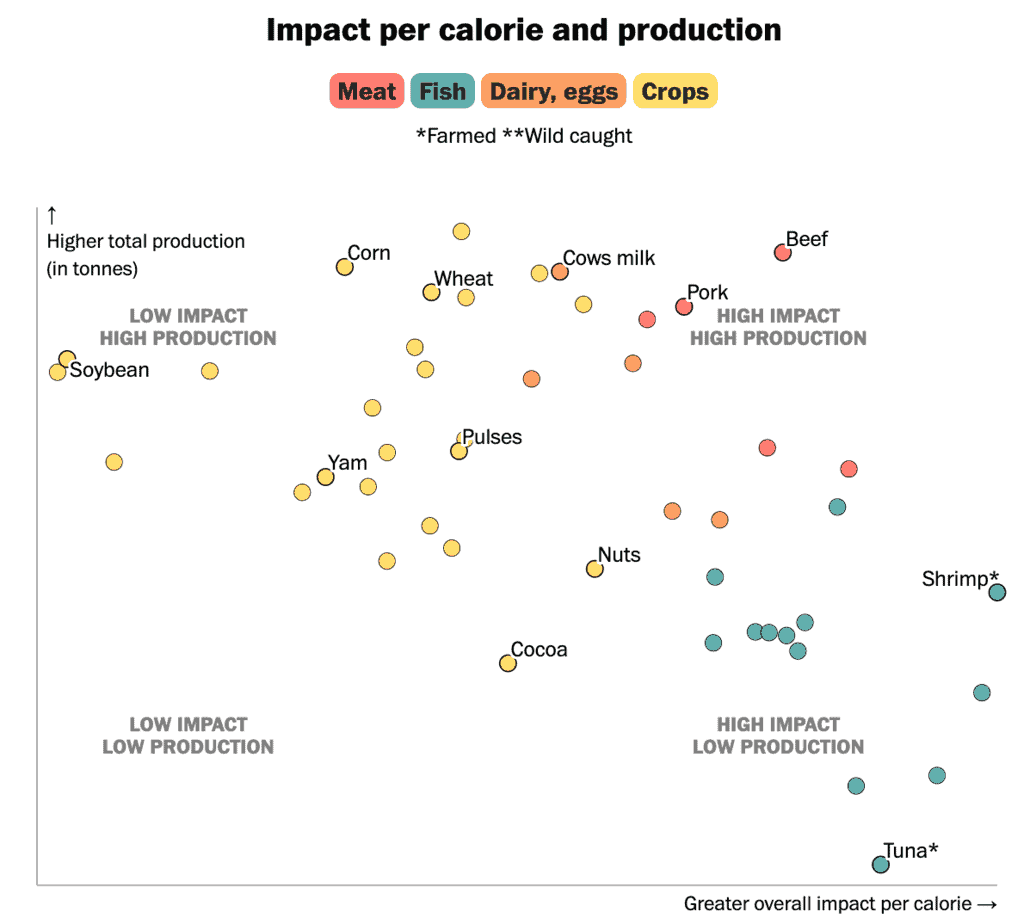
True sustainability requires looking at the full picture. It is clear that vegan diets can lead to dramatic reductions in emissions and biodiversity loss. But if people following these diets don’t eat diverse protein sources like beans and legumes, they can also rely on crops – like soy – that are grown unsustainably. And in terms of animal agriculture, animal products differ in how much they affect the environment, while organic methods and regenerative grazing can reduce their climate change impacts.
In some ways, but it’s complicated. Organic can refer to a set of practices, to a movement, or to a certification – and these are somewhat different. As a practice, organic agriculture is a way of farming that uses natural methods to manage and grow crops, instead of chemical pesticides and fertilizers. For almost all of human history until about a hundred years ago, all food was produced organically. And even as farming has become more industrialized, many communities of the global majority have continued to farm in restorative and organic ways.
The organic agriculture “movement” started because people were concerned about the growing use of nitrogen fertilizers in the early 1900s. During World War I, scientists figured out how to turn nitrogen from the air into nitrates, through a process that required a lot of fossil fuels. These nitrates were used to create both bombs and fertilizers. (Many of the world’s biggest ag corporations, like Monsanto, which is now owned by Bayer, produced herbicides that were used both in agriculture and in military violence, such as when the US sprayed Agent Orange in Vietnam.) Big agriculture corporations increasingly pushed fertilizers onto farmers, replacing traditional methods of building soil fertility. In response to this, the organic agriculture movement has advocated for a return to traditional methods. But historically, it has erased the contributions of Black, Indigenous, and other farmers of color, who have continued to hold this knowledge and farm in organic ways.
In the US, there is a process of organic certification that ensures that farmers and ranchers have used specific eco-friendly practices. But organic certification has many problems. Certification is expensive and time-consuming. In particular, USDA rules make it very difficult for small farmers and farmers of color to get certified. Plus, organic certification doesn’t mean that a farm treats its workers well in terms of wages or working conditions. (However, organic farms do avoid exposing workers to toxic pesticides and other chemicals used in industrial farming.) Some alternatives to organic certification, like the Food Justice Certification by the Agricultural Justice Project, take these issues into account.
The market for organic food continues to increase, encouraging more farmers to transition to more sustainable methods. Some policies try to assist with this transition. But this ends up benefiting larger farms that are currently using harmful methods. We need to ensure that organic efforts support growers – especially growers of color – who have always farmed in sustainable ways and continue to do so.
Finally, many farms that qualify as organic do not help restore ecosystems. Simply not using chemicals is a very low bar. Large farms dominate the organic market, often prioritizing profit over deeper commitments to regenerative farming. Many of these large organic farms resemble factory farms, growing row upon row of one crop or raising huge numbers of animals on feedlots. By contrast, a healthy, thriving ecosystem requires biodiversity. To be truly ecological, farms require a range of plants and animals to build rich soils, attract pollinators, and protect against disease.
Organic agriculture is better than industrial agriculture, and it is a step towards sustainability. But we must ensure that our agricultural systems are ecological. We need to make sure that government agencies’ funding for organics supports ecological practices like those of small-scale growers of color who have long been stewards of the land — not the handful of corporations and mega-farms who have co-opted this movement and do the bare minimum of meeting organic standards.
For thousands of years, Indigenous peoples and other traditional land stewards around the world have fed their communities while also enriching soils, protecting water, and helping other species to thrive. But through the colonization of the Americas, Africa, and Asia over the past 500 years, white Europeans have sought to replace these systems with private property ownership and exploit land, water, and other beings as resources. In the US, white colonizers have stolen the land collectively stewarded by Indigenous peoples, bringing it under intensive cultivation systems that have released huge amounts of carbon into the atmosphere. Through colonization, genocide, and enslavement, white landowners and corporations have come to control the majority of land and property, while creating laws and structures that prohibit others from accessing it. They have reaped profits and generational wealth by taking land that was made fertile through generations of care by Indigenous peoples, and by enslaving or underpaying those who worked, or work, the land. This system is based on extraction: the exploitation of working people, the depletion of soil and water, the use of fossil fuels, and the widespread theft of land.
We cannot transition to sustainable and regenerative food systems without the return of land to Indigenous people and other land stewards. In many cultures, land is viewed not as a resource to be exploited, but as relations and kin. And it is often stewarded collectively, considering the diverse needs of human and ecological communities – not through private forms of ownership that can intensify resource exploitation and land degradation. Increased land access for people of color enables those who have long relationships of care with the land to recover cultural traditions and implement practices that restore soils and repair landscapes. At the same time, we need policies and programs to strengthen land tenure, to ensure that people can invest money and time in their farms without facing threats of eviction or removal. This is why many groups are currently pushing for the Justice for Black Farmers Act, recognition and support for heirs’ property, and movements for Land Back to Indigenous peoples. When done in more transformative ways, the return of land can also move away from destructive Euro-American frameworks of private ownership, democratizing food production and stewardship and protecting the rights of water bodies, land, and other beings in our ecosystems.
Technology enthusiasts often suggest that new innovations can solve problems in our food system. They suggest that these technologies can reduce the use of land, water, and chemicals and can make farming more efficient and productive. Technology is political. Decision-makers weigh the dangers and benefits of creating or using a given technology, and they determine who owns it and how people can access it. When politicians allow corporations to make these decisions, technology ends up serving the interests of the wealthy few, rather than benefiting all of us and the earth.
Let’s take a closer look at a few of the commonly proposed technological solutions in agriculture:
- Genetically-modified organisms (GMOs) are organisms whose DNA has been altered in a lab to produce certain traits. GMOs go against many communities’ cultural values and the important role of native and heirloom crop varieties in food sovereignty and self-determination, especially among Indigenous peoples around the world. They have also been a source of intense scientific debate. Although these debates are numerous and complex, it is worth noting a few key findings. Studies have shown that GMOs often do not have higher yields than conventional or organic crops. Most GMO crops are destined as feed for factory-farmed animals, and they are grown in industrial agriculture systems that are bad for soil health and wider sustainability. GMOs can also contaminate non-GMO and organic crops. And farms that grow GMOs often end up applying more chemical herbicides. Furthermore, a handful of agribusiness corporations and labs produce and sell GMOs. This takes more control over seeds away from farmers and communities, while further reducing the variety of seeds and foods that we can grow. As we confront the realities of climate change, it is essential to have access to diverse heritage seeds, including those that are adapted to drought, flooding, or extreme heat.
- Biodigesters (also known as methane digesters or anaerobic digesters) convert animal manure into fuel and fertilizer. To function properly, biodigesters need huge amounts of manure and additional materials. Because of this, they are mostly suitable for very large farms, like concentrated animal feeding operations (CAFOs), aka “factory farms.” (Learn more about the problems with CAFOs and efforts to eliminate them!) Rather than solving the climate crisis, biodigesters can actually release more toxins and greenhouse gases into our air. When the government provides funding support for these expensive systems, this can take away from proven solutions among small-scale growers and growers of color. Biodigesters can contribute to sustainability if used on community-run or collective farms for which they are appropriately scaled. Some community groups and large institutions (like universities) have already installed and operate biodigesters.
- Digital agriculture refers to the use of technologies like Artificial Intelligence, drones, Blockchain, and software applications and platforms to digitize various aspects of food production. A key element of this is precision agriculture. Precision agriculture uses geospatial data, automation, and software to monitor field conditions on site. Some people claim that these technologies will make agriculture more sustainable by allowing for more precise doses of fertilizers and pesticides and better resource management. However, many of these technologies come with other problems. While larger operators with more money and infrastructure can take advantage of these innovations, they are too expensive and impractical for most farmers. In addition, some technologies rely on big data and algorithms to make farming decisions, devaluing farmers’ knowledge and skills. Through these technologies, corporations and data managers are able to collect huge amounts of data about farmers’ practices and land. They can often then sell that data to other corporations, insurance companies, or banks. This raises concerns about privacy, data ownership, and implications for credit and land tenure. From an environmental perspective, digital agriculture relies on massive data centers and other technologies that have very high levels of emissions and other environmental impacts. When used in very specific ways aligned with food sovereignty principles, some digital technologies can benefit small-scale growers and contribute to sustainable and regenerative practices. For example, many farmers and community groups use GPS and other digital technologies to advance land rights.
- Vertical farming uses stacked layers to grow food (and sometimes even raise fish) in indoor environments, like warehouses. In the early 2000s, some community groups used vertical farms to produce healthy food without requiring large tracts of land. This is especially important in urban areas and reclaimed brownfield sites where the land itself may contain toxins from past industrial activity. But in recent years, corporations, tech start-ups, and investors have been creating high-tech, AI-run vertical farms that require vast greenhouses and artificial lighting – all of which requires a lot of energy. In these cases, vertical farming is not socially, economically, or environmentally sustainable. Many of these vertical farms are already starting to go bankrupt. Additionally, vertical farming does nothing to improve the quality of soil and is limited in its ability to provide other ecosystem benefits.
We have already seen the negative effects of relying on technology alone to solve social problems. From the 1940s to the 1980s, the Green Revolution promised to end hunger in Asia and Latin America through chemical inputs, new crop varieties, irrigation systems, and mechanization. But as a result of the Green Revolution, farmers found their water and soils contaminated with toxic chemicals, and cancer rates have skyrocketed. Privately-owned seeds squeezed out Indigenous crop varieties, reducing diversity in what people grew and ate. Larger and more privileged farmers took over land from small farmers (especially women and marginalized racial or ethnic groups) who could not afford expensive inputs. Farmers have been forced to go into debt, paying more and more for inputs. In India, debt-related farmer suicide rates have increased as a result of the Green Revolution. And in many cases, even when more food was produced, it remained inaccessible to many people who needed it.
We must remember that technology is never value-neutral. At present, many technological innovations serve the billionaires and corporations who design them, sell them, and use them to collect data. For new technologies to advance sustainability and benefit the people who grow our food, we need to ask tough questions about who owns them (and their data), what purposes they’re serving, and whether and how they can advance food sovereignty and liberation.
The US government (and other governments and institutions) have created new initiatives around climate-smart agriculture (CSA). CSA groups together a lot of practices that claim to reduce greenhouse gas emissions and increase agricultural resilience. Some CSA projects are supportive of small-scale and BIPOC growers, agroecology, and sustainability. But others promote carbon markets (which do not work) or high-tech solutions unavailable to most of the people who grow our food.
It is important to ensure that projects and funding sources are behaving in ethical ways. USDA has not been very transparent about its spending on CSA and often doesn’t have the resources to adequately monitor benefits. Other groups have found that much of the existing CSA funding has not actually gone to farmers using sustainable practices. CSA support should go to true climate solutions, led by small- and mid-scale growers and local communities.
There are many different terms – like sustainable, regenerative, and agroecological – that describe farming practices that nurture and care for land, air, and water. Although many of these terms have been created fairly recently (often by white activists or academics), food growers of the global majority have grown and caught food this way for thousands of years.
Sustainable agriculture refers to farming practices that ensure that future generations of people and other species can thrive. The term was coined in the 1970s and has since become mainstream. It is used widely by nonprofits, farmers, and government agencies. However, many corporations also use the term to greenwash their activities. (Greenwashing is when corporations use images and narratives that make them seem environmentally friendly, even though they still engage in destructive practices).
Some people prefer the term regenerative agriculture, which moves beyond simply sustaining food production. Regenerative agriculture is about farming in ways that restore and care for the land, soil, water, and other beings. Indigenous peoples and other land stewards hold worldviews and ethics that have always been regenerative. These communities practice care for multiple generations and diverse species. In many cases, they also hold deep ancestral and sacred connections to specific places and regions. These worldviews go hand in hand with the use of farming methods that create and maintain healthy soils and ecosystems. Indigenous, Black, and farmers of color have been central in shaping the practice of regenerative agriculture. But the regenerative agriculture movement has often excluded them and has failed to sufficiently address discrimination, land tenure, and systemic racism. To address these issues, many organizations and foundations are now working to support the decision-making power of Black, Indigenous, and farmers of color and uplift their long-standing leadership in regenerative agriculture.
Agroecology means modeling farms and fisheries on ecological processes and social principles. People who use agroecology observe and learn from their local ecosystems, and they grow food in harmony with other beings. Agroecology also emphasizes social principles like fairness and participation in decision-making. Although the term agroecology was only created in the 1970s, small-scale farmers, ranchers, and fishers around the world have employed these practices and principles for thousands of years.
Traditional ecological knowledge (TEK) refers to local and Indigenous knowledge, practices, and beliefs. TEK is held by people who are materially and spiritually integrated with land and who have long histories of attentiveness to the landscape. It is important in agriculture and food production, but can also be applied more widely to other issues in environmental stewardship.
There is no single correct term to use across the board. All of these terms and frameworks can be (and are) used by food growers, activists, and allies to build collective power for non-extractive and racially-just agricultural models. At the same time, none of these terms is completely free of problems. Corporations, politicians, and white activists have already co-opted many of them, profiting off of locally-grounded and Indigenous knowledge while erasing the holders of this knowledge. The terms themselves are less important than the specific practices and frameworks that they describe, the goals in using them, and who is included in the conversation.
There are also many food growers around the world who don’t use any of these terms, but still employ practices that nurture ecological and human relationships.
Thanks to many years of organizing and policy advocacy, the US government now provides more financial, research, and technical support for sustainable agriculture. The US Department of Agriculture (USDA) has a number of programs for doing this, including the Sustainable Agriculture Research and Education (SARE) program, the National Organic Program, the Conservation Stewardship Program, and the Environmental Quality Incentives Program (EQIP), among others. For Native food growers, support is also available through the Office of Tribal Relations. Funding for these programs is determined by the farm bill, passed by Congress every five years. (Learn more about HEAL’s work on the farm bill!)
We also need a clear, centralized government agency to support sustainable fisheries. For example, we could have an independent National Seafood Council that represents and includes small-scale and community-based fishers. In the meantime, the National Oceanic and Atmospheric Administration (NOAA) must use its existing resources to support community-based fishers and seafood businesses – starting with the $2.6 billion it received through the Inflation Reduction Act. At present, these groups can apply for grants through the NOAA Saltonstall-Kennedy grant and the USDA Local Agriculture Market Program (LAMP).
In addition to government sources, there are progressive philanthropies that support sustainable agriculture. The Sustainable Agriculture and Food Systems Funders network is a good place to start when researching foundations that provide this kind of support.
Food growers can also benefit from engaging with existing peer networks, or creating their own. Through these kinds of networks, growers can exchange information, socialize, and learn from each other. These networks include (but are not limited to) regional networks like the Northeast Farmers of Color Land Trust, Midwest Farmers of Color Collective, and Southeastern African American Farmers’ Organic Network; agricultural collectives like the Agri-Cultura Cooperative Network; and national networks like National Black Food and Justice Alliance, HEAL, and the North American Marine Alliance.
Learn more from our members working on these issues! See the resources list below for a list of publications, trainings, and funding opportunities.
Help us fight for policy change! HEAL Food Alliance and our members are pushing for policy change to support small-scale, BIPOC-led solutions, and we’d love your support on current initiatives! Even with increased government support for ecological practices in recent years, this is still a tiny drop in the bucket compared to the money supporting industrial agriculture. In order to make a big shift to sustainable food production, we need Congress to increase and expand funding for USDA sustainable agriculture programs. We need additional grant funding for sustainable growers. We need more research funding for agroecology and Indigenous food production methods. We need policies that ensure that BIPOC land stewards can access and remain on their land. And we need the federal government to recognize and fund Traditional Ecological Knowledge, including in the farm bill. At the same time, we have to push for policies that discourage and penalize harmful farming practices – see more about our and our partners’ work on this here! And we have to ensure that well-intentioned policies don’t end up hurting the people they’re meant to help. For example, the Food Safety Modernization Act has ended up hurting small farmers using ecological practices and integrating animal and crop growing, instead of targeting factory farms whose practices are more dangerous for public health and food safety.
You can help us take action on current policy issues — find out how you can get involved here!
Support local growers using sustainable practices, by donating in support of our member organizations [link to members list below] and using your voice and your vote in line with our demands. You can also consider contributing money, land, or other resources in support of the return of land to Indigenous peoples, who have stewarded land sustainably for many generations. (Some Native Nations and Tribes offer opportunities for settlers to pay land taxes or donate land.)
Resources
National Black Food and Justice Alliance:
Black Food & Justice Interactive Glossary
National Black Food Map and Directory
North American Marine Alliance:
Sustainable Seafood Guide
Aquaculture Values Report
Soul Fire Farm: Ending Racism and Injustice in the Food System
Real Food Media: Anna Lappé & Food MythBusters, Do We Really Need Industrial Agriculture to Feed the World?
Land Loss Prevention Project: Resources
National Black Food and Justice Alliance: Land Stewardship Trainings
Soul Fire Farm: FIRE Immersion Program
Food Animal Concerns Trust (FACT): Fund-a-Farmer Grants
Rodale Institute: BIPOC Farmer Micro-Grants
Sustainable Agriculture Research and Education: Farmer and Rancher Grant
Liberating Investment in the Food & Farm Ecosystem (LIFE) grants to support people of the global majority
